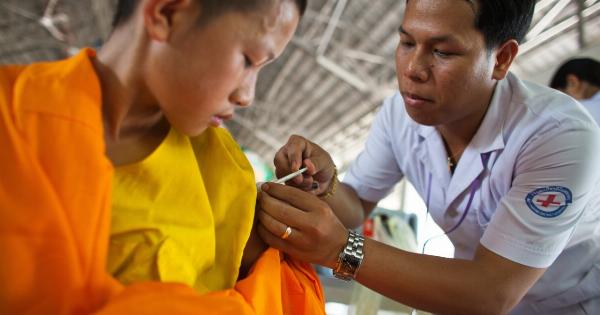Pediatric cancer is a devastating diagnosis that affects not only the physical health but also the emotional well-being of young patients.
The treatment journey can be long and challenging, filled with hospital stays, medical procedures, and a whirlwind of emotions. In such distressing times, dogs have emerged as powerful allies, bringing comfort, joy, and hope to these brave fighters.
This article explores the incredible bond between pediatric cancer patients and their furry friends, highlighting the numerous benefits that dogs provide throughout the treatment process.
1. Emotional Support and Stress Reduction
One of the remarkable aspects of having dogs around pediatric cancer patients is the emotional support they offer. Dogs have an intuitive ability to sense emotions and provide unconditional love and companionship.
Research has shown that interacting with dogs can drastically reduce stress and anxiety levels among patients, soothing their minds and helping them cope with the psychological toll of cancer.
The presence of dogs has been proven to stimulate the production of “feel-good” hormones such as oxytocin, serotonin, and dopamine, which contribute to a sense of happiness and well-being.
This effect is especially significant for young patients who often experience feelings of isolation, fear, and sadness. The simple act of petting a dog or snuggling up to one can bring immense comfort and normalcy to their lives.
2. Distraction and Entertainment
Pediatric cancer treatment protocols often involve lengthy hospital stays, numerous medical procedures, and overall monotony.
Dogs can be a great source of distraction and entertainment for these children, lifting their spirits and providing them with much-needed diversion from the routine. Whether it’s playing fetch, teaching tricks, or just spending quality time together, dogs offer a welcome break from the challenging reality of cancer.
Interacting with dogs can also help children focus on something other than their illness. It encourages them to live in the moment, creating a positive environment filled with laughter, joy, and excitement.
This distraction not only helps alleviate boredom but also promotes a positive mindset, contributing to their overall well-being and enhancing their ability to cope with treatment.
3. Companionship and Decreased Feelings of Isolation
Being a pediatric cancer patient can often make individuals feel isolated from their peers due to their medical condition. Dogs act as a bridge, connecting these brave children with the outside world and easing their sense of isolation.
A dog’s unwavering companionship and non-judgmental attitude provide a unique bond that is incredibly valuable during these difficult times.
Not only do dogs provide companionship, but they can also act as social catalysts, encouraging interactions with other patients, family members, and medical staff.
The presence of these four-legged friends can create a shared experience, making it easier for children to communicate their feelings, fears, and hopes with others. Dogs have the extraordinary ability to break down barriers and create a sense of unity, instilling a feeling of belonging within the pediatric cancer community.
4. Motivation and Positive Reinforcement
Dogs have an innate ability to make people feel loved, appreciated, and motivated. For pediatric cancer patients, this motivation can make a huge difference in their treatment journey.
The presence of a dog can act as a driving force, encouraging children to stay strong and resilient during difficult procedures or treatments.
Furthermore, dogs can also be incorporated into various therapy sessions, becoming instrumental in promoting physical activity and rehabilitation.
Activities such as walking, grooming, and practicing commands can help patients regain strength, improve motor skills, and enhance their overall physical well-being. The bond between a child and their therapy dog creates a positive association with treatment, making it more enjoyable and less daunting.
5. Decreased Pain Perception and Improved Healing
Research has shown that interaction with dogs can result in decreased pain perception among patients.
The physical touch and emotional support provided by dogs trigger the release of endorphins, natural pain relievers that promote a sense of well-being and help alleviate discomfort. This can be particularly valuable for pediatric cancer patients who often undergo painful procedures and treatments.
Additionally, studies have suggested that the presence of dogs can have a positive impact on healing.
The favorable emotional and physiological responses generated by these interactions stimulate the body’s natural healing processes, potentially leading to a quicker recovery time. The love and support provided by dogs create an atmosphere conducive to healing, enhancing the overall treatment outcomes for young cancer fighters.
6. Enhanced Communication and Coping Skills
Communication can be a struggle for pediatric cancer patients, especially when it comes to discussing their illness, fears, or concerns. Dogs can play a pivotal role in helping these children develop and strengthen their communication and coping skills.
The non-judgmental nature of dogs provides a safe space for patients to express themselves freely.
Through interacting with dogs, children can learn to trust, open up, and articulate their emotions.
This newfound communication ability extends beyond the dog-patient relationship and improves their interactions with family members, friends, and medical professionals. Dogs become valuable assets in empowering these young patients, helping them navigate their cancer journey while developing essential life skills.
7. Faith and Hope
Pediatric cancer treatment can be an arduous and challenging process, often testing the faith and hope of both patients and their families.
Dogs provide an unwavering source of faith and hope, reminding these brave individuals that there is always love, joy, and purpose even in the most difficult times.
Their unconditional love, loyalty, and resilience serve as shining examples for pediatric cancer patients, offering inspiration and encouragement. Dogs are living proof that even in the face of adversity, one can find strength and beauty.
This message resonates deeply with young fighters, nurturing their faith in recovery and igniting a spark of hope that fuels their determination to overcome the obstacles before them.
8. Complementary Therapy and Canine-Assisted Interventions
Canine-assisted interventions have gained significant recognition as complementary therapies for pediatric cancer patients.
These interventions involve the presence of specially trained therapy dogs that work alongside medical professionals, offering support and comfort in various healthcare settings.
Therapy dogs can be incorporated into psychosocial care, pain management, and therapeutic activities, among other services.
Their presence during treatments and consultations can significantly improve patient experiences, thereby complementing the medical interventions and enhancing the overall quality of care.
9. Improved Treatment Compliance and Overall Well-Being
Pediatric cancer treatment protocols can be demanding and challenging to comply with, especially for young patients. However, the presence of dogs has shown to improve treatment compliance rates among children.
The anticipation of spending time with their furry friends can act as a powerful motivator, encouraging patients to adhere to medication schedules and follow treatment recommendations.
Moreover, studies have suggested that the overall well-being of pediatric cancer patients is significantly enhanced when dogs are present.
From decreased levels of pain and anxiety to improved mood and self-esteem, dogs contribute holistically to a child’s quality of life. By addressing the physical, emotional, and social aspects of well-being, dogs become invaluable members of the healthcare team, working to improve treatment outcomes for young cancer patients.
10. Family Support and Strengthened Bonds
The impact of dogs extends beyond the patients themselves and spills over to their families. Dogs become a source of comfort and support for not just the child suffering from cancer, but also their parents and siblings.
The presence of a dog can alleviate the emotional burden felt by family members, providing them with a sense of solace and normalcy during these trying times.
Furthermore, caring for a dog can help families strengthen their bonds and foster a sense of togetherness.
Taking responsibility for a pet’s well-being and participating in activities with the dog can create shared experiences and memories, strengthening family relationships and promoting a sense of unity.
In Conclusion
Dogs have an unquestionable impact on the lives of pediatric cancer patients. From offering emotional support and reducing stress to promoting distraction, companionship, and motivation, dogs play diverse roles throughout the treatment journey.
Their ability to improve communication, decrease pain perception, and enhance overall well-being is truly remarkable.
The bond between pediatric cancer patients and dogs transcends words and provides a lifeline in the face of adversity.
These furry friends bring comfort, unconditional love, and a sense of normalcy to young fighters, acting as pillars of strength and hope. As the medical community continues to recognize the invaluable role dogs play in pediatric cancer care, efforts should be made to ensure that every young patient has access to the healing power of a furry companion.































